Casualties during the Rhodesian Bush War
The Rhodesian Government declared Independence from the British in November 1965 so this has been associated with the start of the ‘Rhodesian Bush War’. However, the first casualty was forester "Andrew" Oberholzer of Melsetter who was stabbed multiple times before succumbing while driving away from the ‘Crocodile Gang’ in his Kombi on 4th July 1964. They had infiltrated the country without weapons so when another car approached they fled and his wife and daughter could be saved.
It took another 18 months before a few groups entered the country near Chirundu from 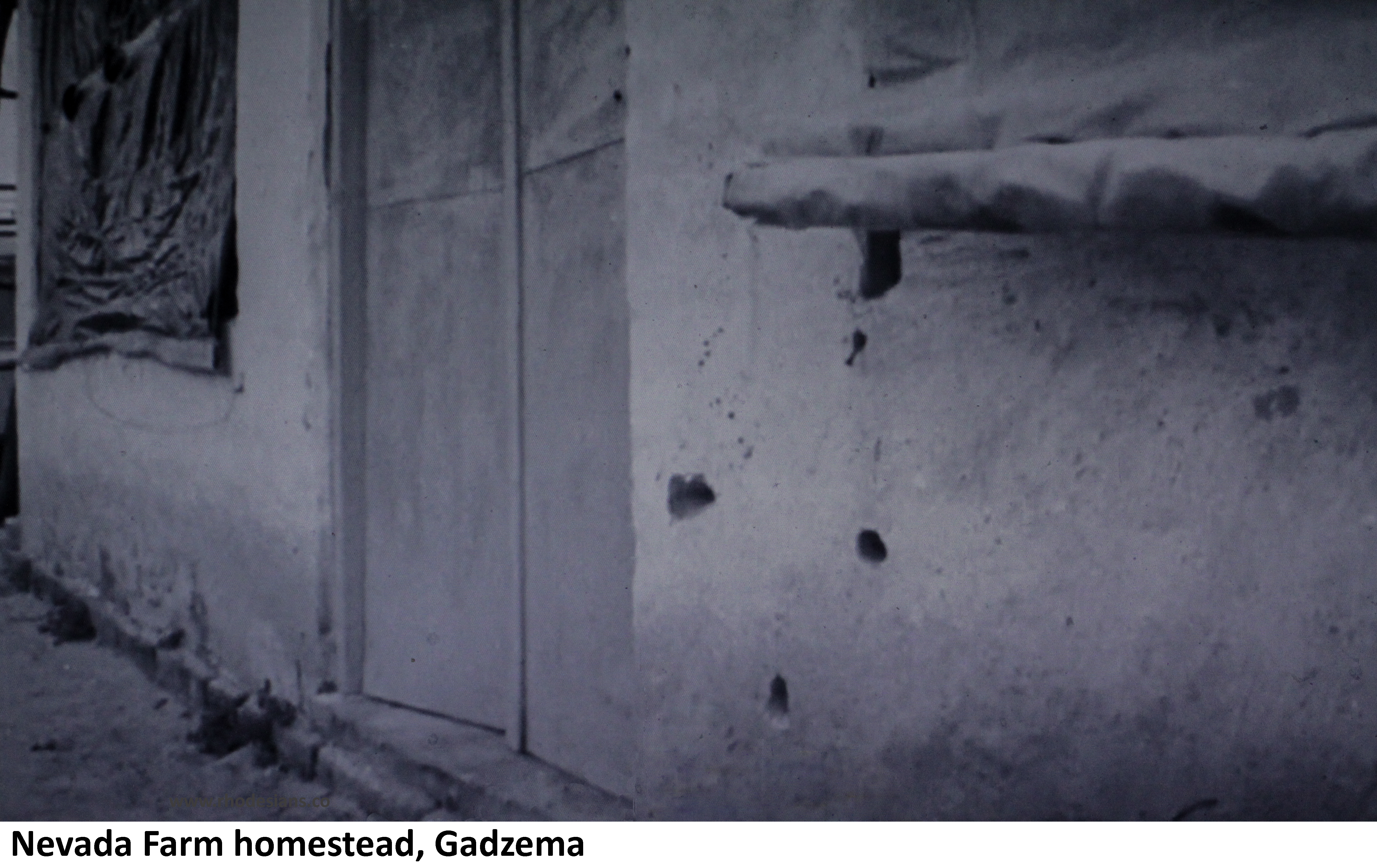 Zambia. The seven ZANLA in one group were killed in the first contact with a paramilitary police unit in what has been called the 'Battle of Sinoia' on 28th April 1966 after attempting to sabotage the powerline from Kariba at a location 11km south-west of Sinoia. Three weeks later, another gang from the same border incursion shot and killed Johannes and Babs Viljoen in their farmhouse in the Gadzema district at 01:00 a.m. on the Monday morning. There was a knock on the door then shooting but two children were unharmed despite the spray of automatic gunfire at the cot. The follow up was commanded by the local police but after these events the Rhodesian Security Forces became the government's primary instrument for conducting counter insurgency operations.
Zambia. The seven ZANLA in one group were killed in the first contact with a paramilitary police unit in what has been called the 'Battle of Sinoia' on 28th April 1966 after attempting to sabotage the powerline from Kariba at a location 11km south-west of Sinoia. Three weeks later, another gang from the same border incursion shot and killed Johannes and Babs Viljoen in their farmhouse in the Gadzema district at 01:00 a.m. on the Monday morning. There was a knock on the door then shooting but two children were unharmed despite the spray of automatic gunfire at the cot. The follow up was commanded by the local police but after these events the Rhodesian Security Forces became the government's primary instrument for conducting counter insurgency operations.
In 1972 ZANLA adopted the revolutionary Maoist tactics that had succeeded on the drive to communism away from the Soviets in China. Mao Zedong, with his rural roots, compared guerrillas to fish, and the people to the water in which they swim. 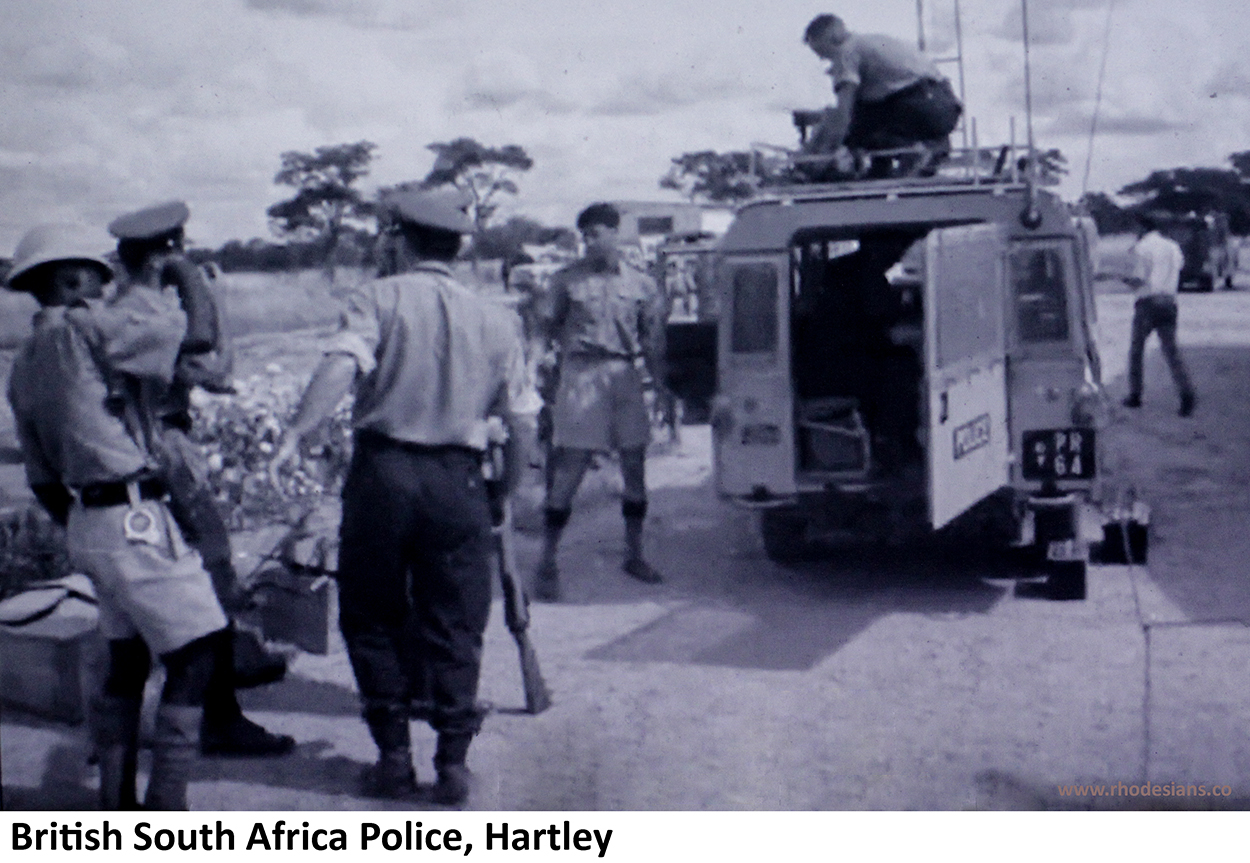
The Rhodesian government reported the loss of 1,361 members of the security forces and that 10,050 terrorists had been killed in Rhodesia between December 1972 and December 1979. 7,790 black civilians and 468 white civilians had also died.
Despite the escalation of numbers of terrorists in Mozambique and Zambia there was reluctance initially by the Rhodesian authorities to cross the border and attack the source. When the pre-emptive raids were carried out against personnel and infrastructure in neighbouring countries, the casualties that were reported appear to have been understated and the debate continues amongst the participants.
On 9th August 1976, 72 soldiers from the Selous Scouts drove into Nyadzonya/Pungwe base in 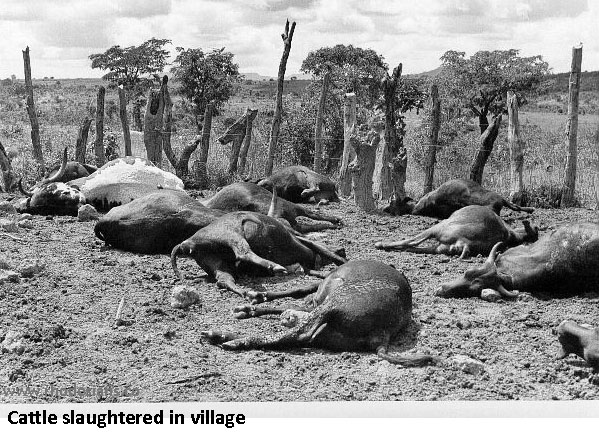 Mozambique and fired on ZANLA troops that were assembled on the parade square. Five Scouts were wounded and two that been left behind by the column but they managed to walk stealithy back to Rhodesia. The United Nations High Commission for Refugees reported 675 deaths. ZANU documents that were captured in another external operation corroborated that number. Yet another ZANU report gave 1,049 deaths with 1,000 missing. On the other hand, Ron Reid-Daly only told about 300 that had been confirmed to have been killed in the Nyadzonya raid.
Mozambique and fired on ZANLA troops that were assembled on the parade square. Five Scouts were wounded and two that been left behind by the column but they managed to walk stealithy back to Rhodesia. The United Nations High Commission for Refugees reported 675 deaths. ZANU documents that were captured in another external operation corroborated that number. Yet another ZANU report gave 1,049 deaths with 1,000 missing. On the other hand, Ron Reid-Daly only told about 300 that had been confirmed to have been killed in the Nyadzonya raid.
Rhodesian sources claim that the attack on ZANLA at Chimoio, Mozambique, in November 1977 resulted in the death of 1,200 and that 700 were wounded. Another report alleges 3,000 deaths with 3,000 wounded.
Operation Gatling targeted the ZIPRA base on Westland Farm, 16 km from Lusaka, Zambia with an airstrike on 19th October 1978 in retaliation to the downing of the civilian aircraft Viscount ‘Hunyani’ on 3rd September 1978. Another two ZIPRA bases were attacked simultaneously. Rhodesian Security Forces lost one soldier and two pilots were wounded. ZIPRA incurred 1,500 deaths and 1,348 were wounded, and some Cuban instructors may have died.
Based on these three significant external ops, total ZANLA and ZIPRA losses are conservatively estimated by the author to be around 5,000 during the conflict.
The loss of 7,790 black civilians from 1972 to 1979 has been split roughly 50% who died 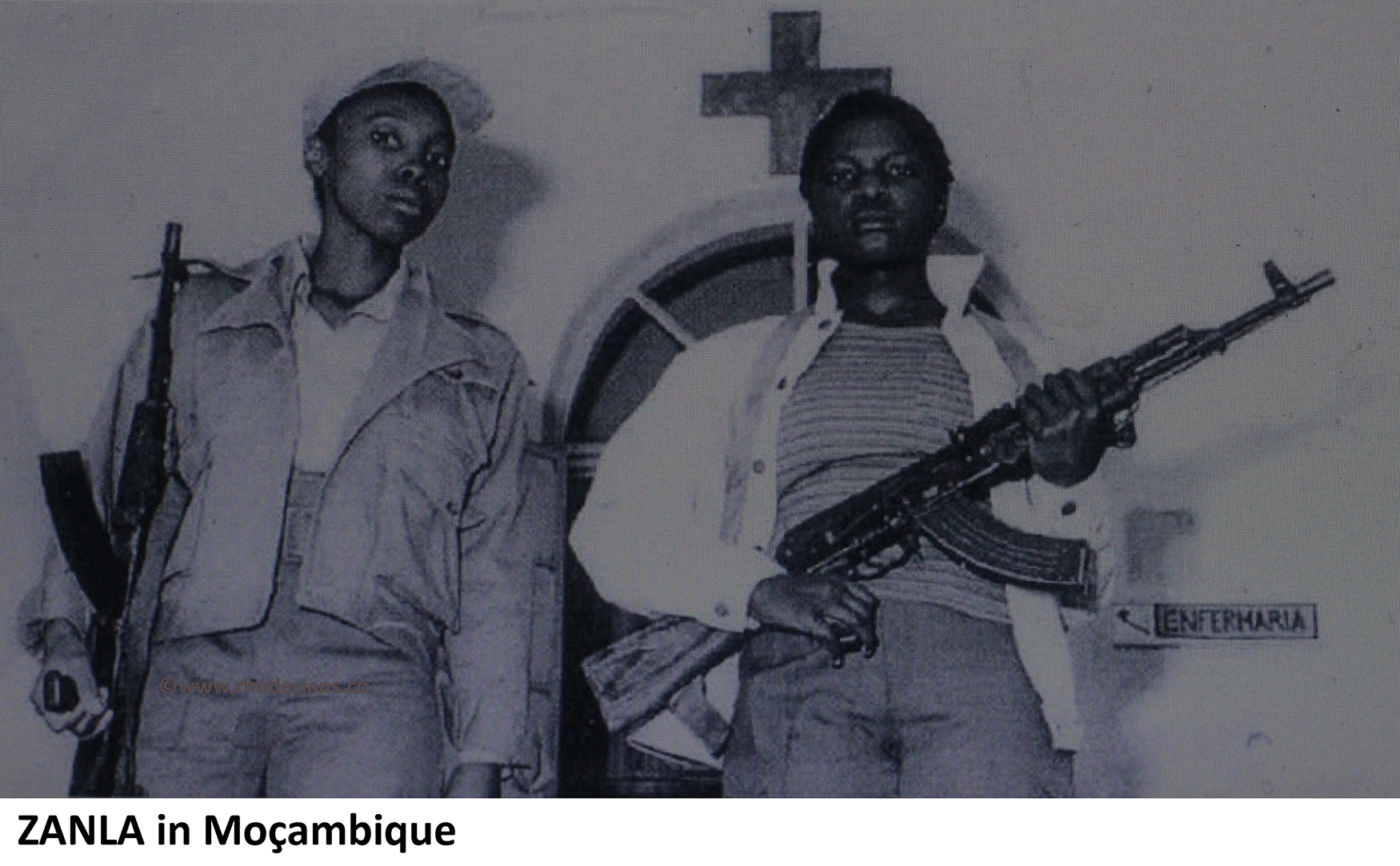 as a result of terrorist actions – many of them as victims of land mines. The other 50% were officially listed as ‘cross-fire’ victims that were caught up in the middle of the conflict. Invariably at least one resident in a village was killed or mutilated for being a ‘sell-out’ during coercion at a ‘Pungwe’ (night-time assembly). The ‘povo’ were the water in which Mao’s fishes were swimming. It is likely that many victims were never reported by their families but the losses accumulated. Accordingly, total black civilian losses from 1965 to 1979 are estimated to be 10,000.
as a result of terrorist actions – many of them as victims of land mines. The other 50% were officially listed as ‘cross-fire’ victims that were caught up in the middle of the conflict. Invariably at least one resident in a village was killed or mutilated for being a ‘sell-out’ during coercion at a ‘Pungwe’ (night-time assembly). The ‘povo’ were the water in which Mao’s fishes were swimming. It is likely that many victims were never reported by their families but the losses accumulated. Accordingly, total black civilian losses from 1965 to 1979 are estimated to be 10,000.
A list of farmers and their families that were killed on their farms or during deployment from 1964 through to present day has been compiled by the author. The original list that had been compiled by the RNFU until September 1979 was corrected, added to and displayed on a website. Losses of white commercial farmers from 1972 to April 1980 number 315. This includes 84 that were away on security force deployment. 50 were in para-military police units, 33 were in Army units and 1 was with Internal Affairs. Those with the police comprised 28 with Police Reserve, 14 with PATU, 7 in BSAP/CID/Ground Coverage or Special Branch whilst 1 was serving with the Police Reserve Air Wing. Many of these were called up to serve in their home districts but most of those that died on call-up with the Army were dispersed widely with several killed during external operations. 11 were with Rhodesia Regiment, 8 with Rhodesian Light Infantry, 4 with Special Air Services, 3 with Rhodesia African Rifles, 2 with the Selous Scouts. 1 was in each of Armoured Cars, Artillery and Engineers. 1 farmer died with another 7 Rhodesia Defence Regiment service men in one engagement.
A total of 115 lives were lost when the two Viscount airlines were shot down by ZIPRA 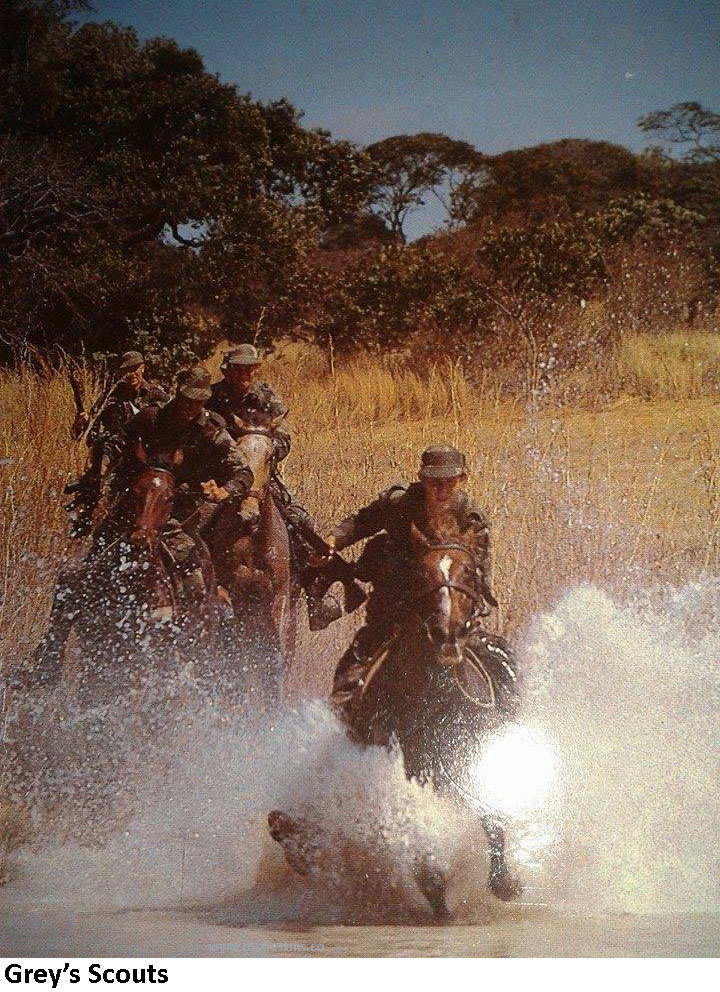 and this includes one black crew member. 39 missionaries were massacred at 11 sites over 19 months. When these are deducted from the total white deaths, the remainder is 84 white civilians that were killed between 1972 and 1980. A modest few were added to this number to extend the number of white civilians back to an origin from 1964.
and this includes one black crew member. 39 missionaries were massacred at 11 sites over 19 months. When these are deducted from the total white deaths, the remainder is 84 white civilians that were killed between 1972 and 1980. A modest few were added to this number to extend the number of white civilians back to an origin from 1964.
After Independence in April 1980, another 54 white farmers and their families were killed on their properties – mainly from dissident attacks in Matabeleland. During the Farm Invasions there was the death of another 27 farmers and their wives. Thousands left their properties, many without their possessions, in order to survive. Theft appeared to be the motive for another four brutal deaths to farming families that occurred up until 2016.
Records that were maintained by some units of the military were not complete. Several surnames are missing. A few units recorded Date of death as the first of each month. Dr J.R.T. Wood compiled the first comprehensive list that was displayed. The author compiled a Rhodesian Bush War ROH which was posted on a website and this flushed out several corrections and additions. This is still work in progress.
There are names of 1,863 serving members from the Rhodesian Security Forces (RSF) plus 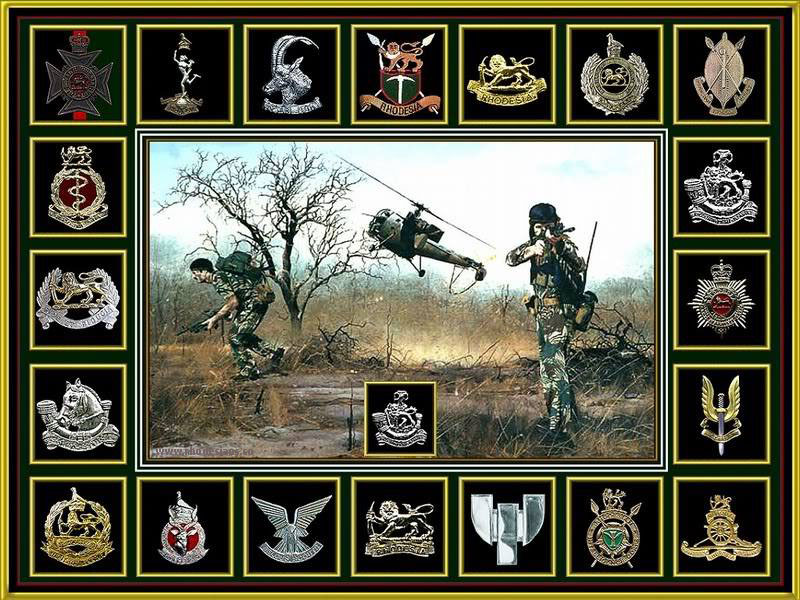 Guard Force and the Ministry of the Internal Affairs that were ‘Killed in Action’ (KIA) or that were ‘Killed on Active Service’ (KOAS) when operational between 1964 and April 1980. 51% were in the Army and 27% were in Police branches. 64% of Police casualties were African and 40% of Army losses were African. In most units, Europeans constituted all of the ‘non-Africans’ amongst the casualties - except for Rhodesia Defence Regiment that was almost exclusively comprised Coloured and Asian. The Ministry of Internal Affairs comprised 15% of the total of which 92% were African. Guard Force was not officially under the RSF and their losses made up 4% of total operational losses and the Air Force 3%.
Guard Force and the Ministry of the Internal Affairs that were ‘Killed in Action’ (KIA) or that were ‘Killed on Active Service’ (KOAS) when operational between 1964 and April 1980. 51% were in the Army and 27% were in Police branches. 64% of Police casualties were African and 40% of Army losses were African. In most units, Europeans constituted all of the ‘non-Africans’ amongst the casualties - except for Rhodesia Defence Regiment that was almost exclusively comprised Coloured and Asian. The Ministry of Internal Affairs comprised 15% of the total of which 92% were African. Guard Force was not officially under the RSF and their losses made up 4% of total operational losses and the Air Force 3%.
1,030 of all operational casualties were African serving members, and this is 55% of the total.
Another 74 serving members succumbed when not on operations or during training so they complete the Killed on Active Service contingent, of which there are 1,937. Refer to the Table below:
| Unit | African |
Other |
Total |
% of total |
| Air Force | 0 |
58 |
58 |
3.0% |
| Police | 27.3% |
|||
| Uniform + CID | 163 |
54 |
217 |
11.2% |
| Support Unit | 85 |
11 |
96 |
5.0% |
| Ground Cover | 13 |
4 |
17 |
0.9% |
| Special Branch | 14 |
11 |
25 |
1.3% |
| Police Reserve | 48 |
81 |
129 |
6.7% |
| P A T U | 6 |
36 |
42 |
2.2% |
| P Reserve Air Wing | 0 |
3 |
3 |
0.2% |
| Army | 50.9% |
|||
| R Regiment | 70 |
202 |
272 |
14.0% |
| R African Rifles | 175 |
35 |
210 |
10.8% |
| R Light Infantry | 0 |
120 |
120 |
6.2% |
| Special Air Services | 0 |
39 |
39 |
2.0% |
| Selous Scouts | 33 |
15 |
48 |
2.5% |
| Grey's Scouts | 3 |
8 |
11 |
0.6% |
| Armoured Car Reg | 2 |
6 |
8 |
0.4% |
| Artillery | 0 |
10 |
10 |
0.5% |
| Education | 0 |
1 |
1 |
0.1% |
| Engineers | 40 |
28 |
68 |
3.5% |
| Intelligence | 1 |
13 |
14 |
0.7% |
| Medical Corps | 0 |
7 |
7 |
0.4% |
| Psychological Op Unit | 2 |
1 |
3 |
0.2% |
| School of Infantry | 4 |
0 |
4 |
0.2% |
| Services Corps | 19 |
2 |
21 |
1.1% |
| Signals | 5 |
8 |
13 |
0.7% |
| Military Police | 0 |
1 |
1 |
0.1% |
| Pay Corps | 0 |
2 |
2 |
0.1% |
| R Womens Services | 0 |
0 |
0 |
0.0% |
| 1 Brigade | 2 |
0 |
2 |
0.1% |
| 2 Brigade | 7 |
3 |
10 |
0.5% |
| 3 Brigade | 4 |
2 |
6 |
0.3% |
| 4 Brigade | 4 |
0 |
4 |
0.2% |
| R Defence Regiment | 1 |
76 |
77 |
4.0% |
| Unit not recorded | 14 |
20 |
34 |
1.8% |
| Guard Force | 66 |
7 |
73 |
3.8% |
| Min of Internal Affairs | 269 |
23 |
292 |
15.1% |
| TOTAL | 1,050 |
886 |
1,937 |
100.0% |
39 serving members of South African units were killed while operating with Rhodesian forces within Rhodesia or in Mozambique. They included volunteers that were badged with the South African Police in the early to mid-1970s. Subsequently pilots from Nos 17, 19, 24 and 42 Squadron, South African Air Force; 5 Reconnaissance Regiment; 3 South African Infantry Battalion, South African Infantry Corps; and the South African Corps of Signals that were serving in South Africa were casualties in either Rhodesia or in Mozambique whilst on joint operations.
| Unit | Black |
White |
Total |
| Recce Regiment | 1 |
5 |
6 |
| S A Air Force | 0 |
7 |
7 |
| S A Infantry | 0 |
1 |
1 |
| S A Police | 2 |
22 |
22 |
| S A Signals | 0 |
1 |
1 |
| TOTAL | 3 |
36 |
39 |
Several South Africans and citizens of other nations were employed in the Rhodesian Security Forces under local conditions so they are classified as ‘Rhodesian’ in this report. Many had experience from the Vietnam War.
There are an additional 587 serving members that Died on Active Service between 1964 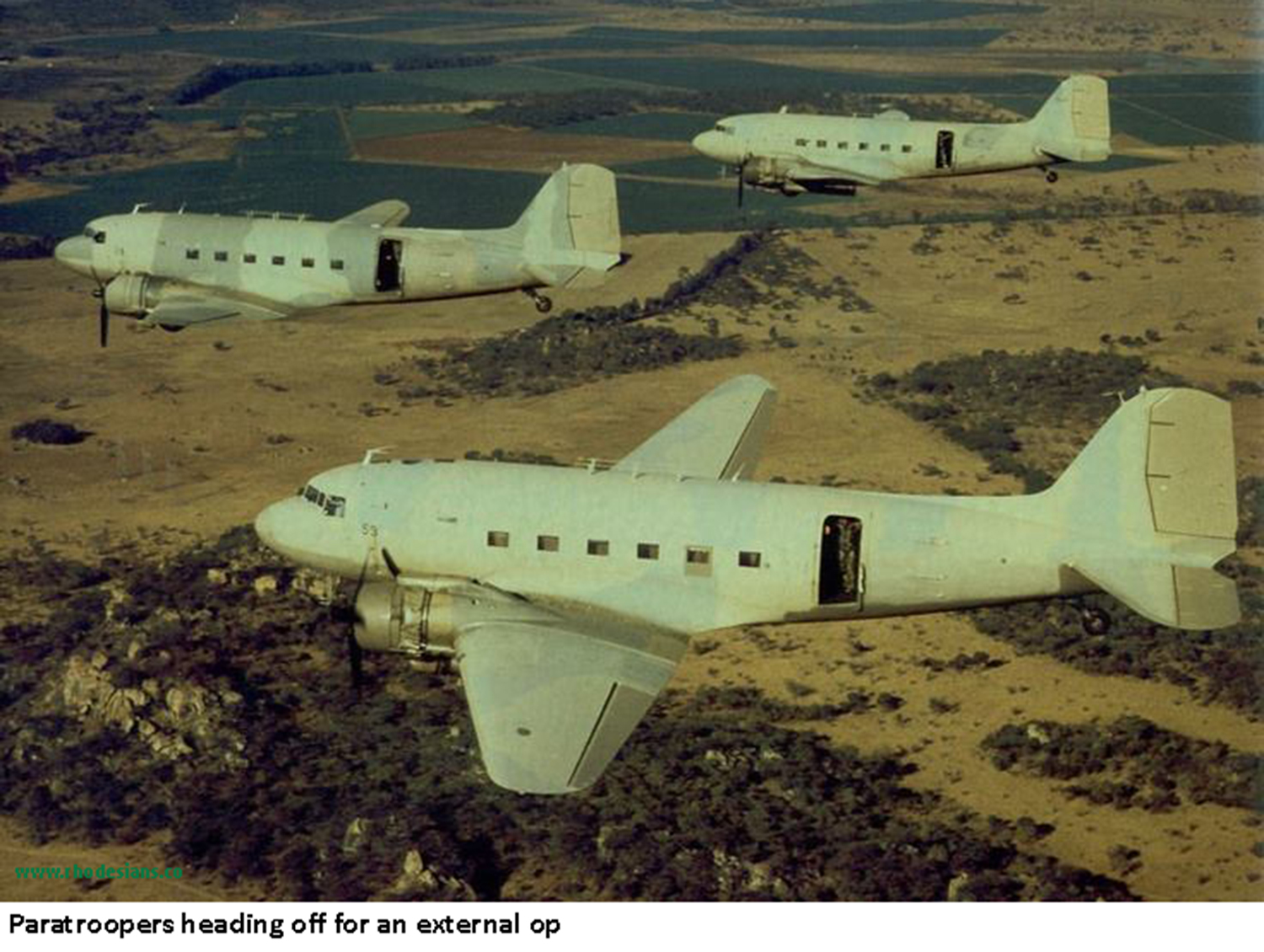 and 1980 that have been added to those that were KIA and KOAS. Mortality from natural attrition and when absent on leave has not been included.
and 1980 that have been added to those that were KIA and KOAS. Mortality from natural attrition and when absent on leave has not been included.
The proportion of deaths from natural causes appears to be higher amongst units with a higher proportion of African serving members, or it might be due to an anomaly in the reporting of those units, or other factors. In the column that includes statistics for DOAS, INTAF and Guard Force increased. Army and the Police declined. The Air Force increased marginally with the inclusion of DOAS casualties. The number of pilots was only around 150 out of the 2,300 personnel on strength, and they were rotated to fly different aircraft to a certain extent. There were very few KIA as most casualties were from accidents or during high risk training.
Historically the British South Africa Police had been responsible for protection of the nation 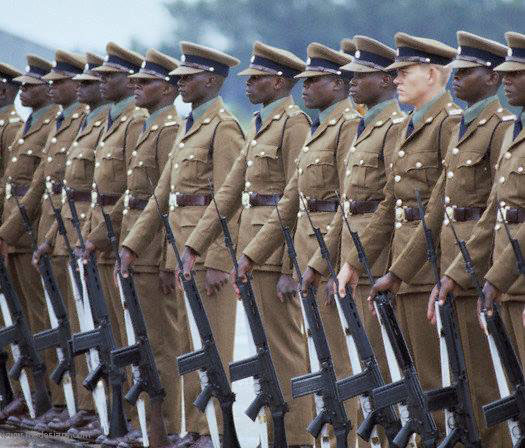 and formed a core when volunteers were called on during the early wars from the Boer War through the World Wars. One source estimated that there were 35,000 Police Reservists in 1979. Their role was one of protection. 24% of all operational Police casualties were reservists, and more than a third of their casualties were Africans. The Black Boots, or Support Unit, started out as trackers. They constituted 18% of the Police casualties and 89% of course were African.
and formed a core when volunteers were called on during the early wars from the Boer War through the World Wars. One source estimated that there were 35,000 Police Reservists in 1979. Their role was one of protection. 24% of all operational Police casualties were reservists, and more than a third of their casualties were Africans. The Black Boots, or Support Unit, started out as trackers. They constituted 18% of the Police casualties and 89% of course were African.
Total casualties in the Rhodesian Bush War are estimated to have been at least 30,000. ZANLA and ZIPRA combined make up 17,000, which is 57% of the total. Two thirds had been killed within Rhodesia. The rural Black population collectively comprised one third of the total. Security Force losses brought up 7% of the total and more than one half of these African serving members. Finally, there were less than 500 White civilians and two thirds of these were farmers.
The military wing of the Nationalist factions had heavy casualties and they in turn inflicted high mortalities and maiming through the rural community. Rhodesian security force losses were comparatively light. As result of this, 6.7 ZANLA/ZIPRA communist terrorists were killed for every Rhodesian military casualty. Only 42% of the total Rhodesian Security Force casualties were White so for every White Rhodesian security force casualty, there were 16 ZANLA/ZIPRA deaths.
Total casualties are summarised in the Table below:
| Location | Group |
Sub group |
Casualties |
| Rhodesia | ZANLA/ZIPRA |
12,000 |
|
| Moz + Zambia | ZANLA/ZIPRA |
5,000 |
|
| Rhodesia | Civilians - White |
Farmers |
234 |
| Rhodesia | Civilians - White |
Airlines |
114 |
| Rhodesia | Civilians - White |
Missionaries |
39 |
| Rhodesia | Civilians - White |
Other |
84 |
| Rhod + Zam + Moz | Military |
Black |
1,463 |
| Rhod + Zam + Moz | Military |
White |
1,027 |
| Rhod + Zam + Moz | Military |
SADF - Black |
3 |
| Rhod + Zam + Moz | Military |
SADF - White |
36 |
| TOTAL | 30,000 |
Civilian losses were high from the Black population of Rhodesia. 10,000 Black 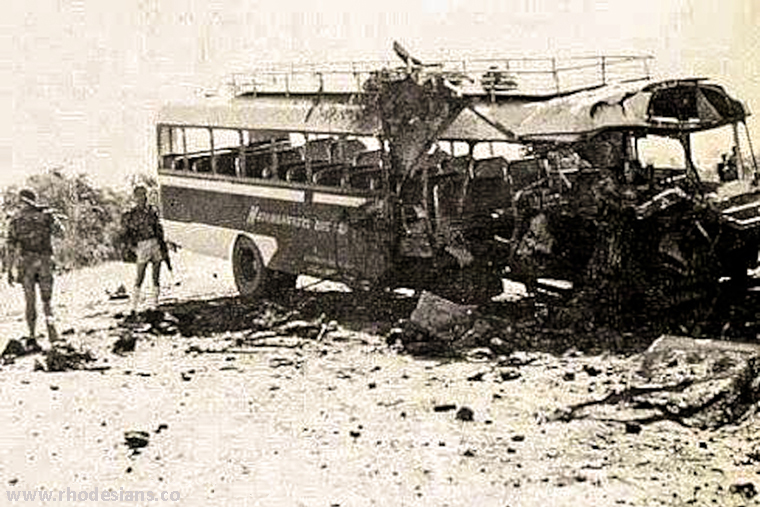 civilians died and 471 White civilians were killed. The ratio of Black to White is 21:1. The White population in Rhodesia peaked in 1976 when it was 8% of the total population. The ratio of Black to White was 11.5:1. This is half the ratio of civilian Black deaths per White. Ironically, half of the Black Civilian casualties were directly due to action by the communist terrorists - such as landmines. Heavy mines that were positioned for army trucks were detonated by buses.
civilians died and 471 White civilians were killed. The ratio of Black to White is 21:1. The White population in Rhodesia peaked in 1976 when it was 8% of the total population. The ratio of Black to White was 11.5:1. This is half the ratio of civilian Black deaths per White. Ironically, half of the Black Civilian casualties were directly due to action by the communist terrorists - such as landmines. Heavy mines that were positioned for army trucks were detonated by buses.
The breakdown by colour is quite stark.
| Colour | Type | Origin | Casualties |
Total |
| White | Civilian | Rhodesian | 471 |
1,534 |
| White | Military | Rhod + SADF | 1,063 |
|
| Black | Civilian | Rhodesian | 10,000 |
28,466 |
| Black | Military | Rhod + SADF | 1,466 |
|
| Black | Military | ZANLA/ZIPRA - Rhodes | 12,000 |
|
| Black | Military | ZANLA/ZIPRA - Moz + Z | 5,000 |
|
| TOTAL | 30,000 |
5.1% of total casualties in the Rhodesian Bush War were White. This is slisghtly above half of their 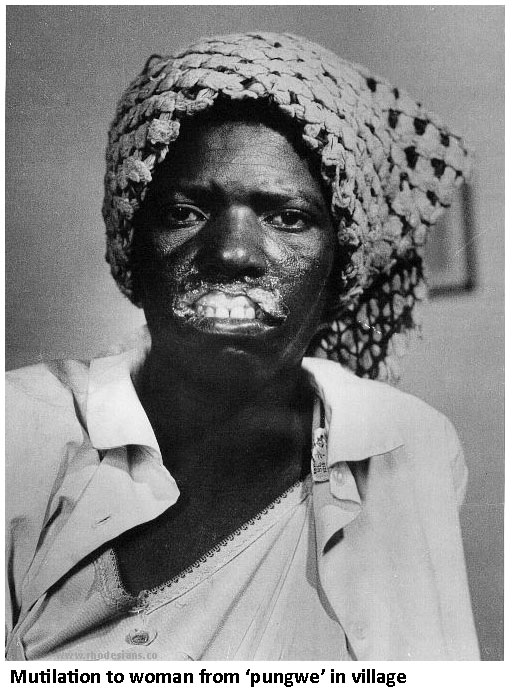 share of the population at that time. The 1,534 lives lost is almost the same as the total Black lives numbering 1,466 that were lost by serving members in the Rhodesian forces.
share of the population at that time. The 1,534 lives lost is almost the same as the total Black lives numbering 1,466 that were lost by serving members in the Rhodesian forces.
The European settler had been the target for the nationalist movements but the Black population turned out to be the biggest victim when casualties were totted up at Independence. The Rhodesian forces demonstrated superiority in the military by inflicting high casualties with less loss. However the outcome was determined by the tainted Ballot. 85% of the population was Shona speaking and ZANU had been more effective with propaganda and the psychological campaign since each brutal “pungwe” since 1972. ZANU took votes from the moderate Blacks that had previously participated in the Zimbabwe Rhodesia.
One party dynasty
30,000 lives over 16 years was a high price to pay for the birth of Zimbabwe on 28th April 1980.
There were much jubilation and Prince Charles joined the celebrations. Within a few years the influence of the British had diminished but that was of no consequence as their chosen protégé had secured the highest nuber of votes so they chose to ignore the intimidation, washed their hands, and Lord Soames flew home.
Ironically when former members of ZANLA and ZIPRA forces that were being integrated 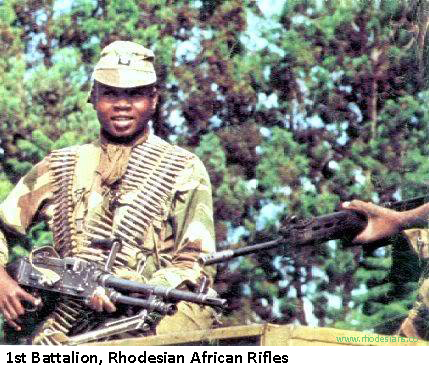 into the national army had a confrontation at Entumbane where they had been mustered; it was their former foe, the Rhodesian Africa Rifles that had been loyal to the Ian Smith government during the civil war, that were called in by Mugabe to intervene; and the Air Force contributed. 300 lives were lost.
into the national army had a confrontation at Entumbane where they had been mustered; it was their former foe, the Rhodesian Africa Rifles that had been loyal to the Ian Smith government during the civil war, that were called in by Mugabe to intervene; and the Air Force contributed. 300 lives were lost.
The North Koreans trained the elite Fifth Brigade for “Gukurahundi” which translates to ‘the early rain which washes away the chaff before the spring rains’. 20,000 Ndebeles are unaccounted for between 1982 and 1987. Joshua Nkomo signed the Unity Accord. The constitution from Lancaster House was replaced and Robert Mugabe continued as head of government by replacing Canaan Banana (who had been co-incidentally disgraced) as President. Through genocide, the once powerful Ndebele nation had succumbed.
The Government reported that 800 dissidents had been killed under Gukurahundi but estimates of the missing range between 3,500 and 30,000 or even higher. There is likely some double counting between the 800 reported by Mugabe’s government and the International Association of Genocide Scholars minimum estimate of 20,000. When civilian losses are added to those during the integration of the national army, the total casualties until the end of 1987 is 21,000. Casualties reported by the government were 429. From this, the author subtracts 54 White farming civilians and 16 White missionaries. The balance could be 350 Black civilians. Dissidents probably may not have exceeded 800. The elimination of 20,000 Ndebele lives in response seems somewhat of an overreaction. On the other hand it had been stated that it had been an objective to declare a one-party state in Zimbabwe by 1985. In reality, it took a little longer than that, but it had been achieved before the end of 1987.
The total price for the declaration of Robert Mugabe as President of Zimbabwe and leader of the de facto one party state since the first casualty to nationalism of 1964 is 51,000 lives. When the statistics are consolidated, it is murky because former comrades in arms reverted to tribal lines after 1980 and details from the Government are deficient.
Between 1964 and 1980, White civilian casualties were 1.6% of the total, and casualties amongst Whites in the military were 3.5%. Total White casualties during the Rhodesian Bush War were 5%. Total White losses until Mugabe became President in 1978 after Ndebele genocide were 3.1%.
Black casualties exceeded 46,000 to comprise 96.9% of Total losses. ZANLA/ZIPRA loses were 36.6% of Total, and 3.1% of Total were Black members of the Rhodesian Security Forces. Total Black civilian casualties were 65% of total Black losses. 43.4% of the total Blacks were Ndebele speakers that disappeared while the Fifth Brigade was deployed. This marked the reversal of the events after 1837 when former Zulu chief Mzilikazi had taken territory from the Shona speaking Karanga. The Ndebele warriors used to take an annual collection or ‘tribute’ from the Shonas until this ceased after the arrival of the White “pioneers” in 1890.
About half of the Black civilian losses during the Rhodesian Bush War (10.8%) were likely due to ZANLA action on fellow Shona speakers during the campaign on Mao Zedong’s philosophy from 1972 onwards.
ZANU PF is the ruling party that retained control in Zimbabwe since Independence, except that Mugabe’s second-in-command and implementer of Gukurahundi assumed control after Mugabe’s humiliating removal by the Generals in a coup d’état. The Shona tribe holds power, but like the Chieftains before the settlers intervened, the spoils are shared by a select few.
A pdf of this report can be downloaded here.
Interest
References
Bennett, Steve, 2021. Website www.rhodesians.co


